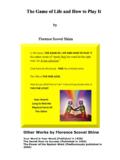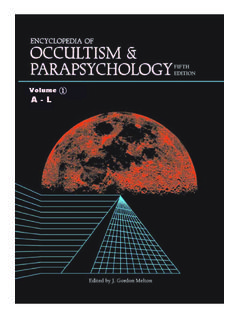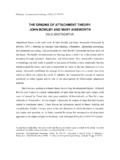Transcription of Raja Yoga - Shards of Consciousness
1 Raja YogaRaja YogabySwami Vivekanda1 Raja Yoga2 Raja YogaTable of First Psychic Control Of The Psychic And And In 's yoga : Its Spiritual : Its - References To Upanishad - Chapter quoted by Shankara [1]..152 Sankhya - Book - Book - Book - Book - Chapter IV, Section YogaPrefixIf there is such a thing as an Age of Aquarius, it began in the late 19th and early 20th centuries. This time period saw the birth of our modern model of the universe as physicists and mathemeticians looked at the world with new eyes. This time period also saw something of a spiritual revival in the United States and Europe as work in Eastern religions began to make its way into the public Consciousness . One of the first missionaries from India came in 1893 to the United States of America to attend, and speak at, the World Parliament of Religions that was taking place in Chicago in that young man, Swami Vivekananda, electrified his audience. He became something of a spiritual rock star of the era.
2 Swami Vivekananda swayed an entire generation, both in the West and in his home country of India, with his lectures, books, and individual book, raja yoga , is one of his most influential works. When I first came across it in my early 20s it was a shock that set me on a path that has lasted my lifetime. It was my first introduction to the philosophy of Vedanta and the practice of meditation, practices that weren't so common in the 1970s as they are now. It helped shaped the basic threads of my philosophy of life more than any other. The first half of the book is based on a series of lectures that Swami Vivekananda gave on the subject of raja yoga . It contains a great deal of practical information on meditation and psychology from the Vedantic point of second half of the book is a translation and commentary on Patanjali's yoga Sutras. The practices espoused in the yoga Sutras have been accepted by most, if not all, of India's schools of YogaRaja yoga , as with all of Swami Vivekananda's writing, is in the public domain.
3 It is, however, difficult to find on the internet, except for a text version on Wikipedia. It is this that I have used to create this formatted version of the text. I trust that the book will be as useful to you as it has been to CockrumShards of YogaPrefaceSince the dawn of history, various extraordinary phenomena have been recorded as happening amongst human beings. Witnesses are not wanting in modern times to attest to the fact of such events, even in societies living under the full blaze of modern science. The vast mass of such evidence is unreliable, as coming from ignorant, superstitious, or fraudulent persons. In many instances the so - called miracles are imitations. But what do they imitate? It is not the sign of a candid and scientific mind to throw overboard anything without proper investigation. Surface scientists, unable to explain the various extraordinary mental phenomena, strive to ignore their very existence. They are, therefore, more culpable than those who think that their prayers are answered by a being, or beings, above the clouds, or than those who believe that their petitions will make such beings change the course of the universe.
4 The latter have the excuse of ignorance, or at least of a defective system of education, which has taught them dependence upon such beings, a dependence which has become a part of their degenerate nature. The former have no such thousands of years such phenomena have been studied, investigated, and generalised, the whole ground of the religious faculties of man has been analysed, and the practical result is the science of Raja- yoga . Raja- yoga does not, after the unpardonable manner of some modern scientists, deny the existence of facts which are difficult to explain; on the other hand, it gently yet in no uncertain terms tells the superstitious that miracles, and answers to prayers, and powers of faith, though true as facts, are not rendered comprehensible through the superstitious explanation of attributing them to the agency of a being, or beings, above the clouds. It declares that each man is only a conduit for the infinite ocean of knowledge and power that lies behind mankind.
5 It teaches that desires and wants are in man, that the power of supply is also in man; and that wherever and whenever a desire, a want, a prayer has been fulfilled, it was out of this infinite magazine that the supply came, and not from any supernatural being. The idea of supernatural beings 6 Raja Yogamay rouse to a certain extent the power of action in man, but it also brings spiritual decay. It brings dependence; it brings fear; it brings superstition. It degenerates into a horrible belief in the natural weakness of man. There is no supernatural, says the Yogi, but there are in nature gross manifestations and subtle manifestations. The subtle are the causes, the gross the effects. The gross can be easily perceived by the senses; not so the subtle. The practice of Raja - yoga will lead to the acquisition of the more subtle the orthodox systems of India philosophy have one goal in view, the liberation of the soul through perfection. The method is by yoga . The word yoga covers an immense ground, but both the Sankhya and the Vedanta Schools point to yoga in some form or subject of the present book is that form of yoga known as Raja- yoga .
6 The aphorisms of Patanjali are the highest authority on Raja- yoga , and form its textbook. The other philosophers, though occasionally differing from Patanjali in some philosophical points, have, as a rule, acceded to his method of practice a decided consent. The first part of this book comprises several lectures to classes delivered by the present writer in New York. The second part is a rather free translation of the aphorisms (Sutras) of Patanjali, with a running commentary. Effort has been made to avoid technicalities as far as possible, and to keep to the free and easy style of conversation. In the first part some simple and specific directions are given for the student who want to practise, but all such are especially and earnestly reminded that, with few exceptions, yoga can only be safely learnt by direct contact with a teacher. If these conversations succeed in awakening a desire for further information on the subject, the teacher will not be system of Patanjali is based upon the system of the Sankhyas, the points of difference being very few.
7 The two most important differences are, first, that Patanjali admits a Personal God in the form of a first teacher, while the only God the Sankhyas admit is a nearly perfected being, temporarily in charge of a cycle of creation. Second, the Yogis hold the mind to be equally all - pervading with the soul, or Purusha, and the Sankhyas do not. The Yoga8 Raja YogaEach soul is potentially goal is to manifest this Divinity within by controlling nature, external and this either by work, or worship, or psychic control, or philosophy -- by one, or more, or all of these -- and be is the whole of religion. Doctrines, or dogmas, or rituals, or books, or temples, or forms, are but secondary YogaIntroductoryAll our knowledge is based upon experience. What we call inferential knowledge, in which we go from the less to the more general, or from the general to the particular, has experience as its basis. In what are called the exact sciences, people easily find the truth, because it appeals to the particular experiences of every human being.
8 The scientist does not tell you to believe in anything, but he has certain results which come from his own experiences, and reasoning on them when he asks us to believe in his conclusions, he appeals to some universal experience of humanity. In every exact science there is a basis which is common to all humanity, so that we can at once see the truth or the fallacy of the conclusions drawn therefrom. Now, the question is: Has religion any such basis or not? I shall have to answer the question both in the affirmative and in the , as it is generally taught all over the world, is said to be based upon faith and belief, and, in most cases, consists only of different sets of theories, and that is the reason why we find all religions quarrelling with one another. These theories, again, are based upon belief. One man says there is a great Being sitting above the clouds and governing the whole universe, and he asks me to believe that solely on the authority of his assertion. In the same way, I may have my own ideas, which I am asking others to believe, and if they ask a reason, I cannot give them any.
9 This is why religion and metaphysical philosophy have a bad name nowadays. Every educated man seems to say, "Oh, these religions are only bundles of theories without any standard to judge them by, each man preaching his own pet ideas." Nevertheless, there is a basis of universal belief in religion, governing all the different theories and all the varying ideas of different sects in different countries. Going to their basis we find that they also are based upon universal the first place, if you analyse all the various religions of the world, you will find that these are divided into two classes, those with a book and those 10 Raja Yogawithout a book. Those with a book are the strongest, and have the largest number of followers. Those without books have mostly died out, and the few new ones have very small followings. Yet, in all of them we find one consensus of opinion, that the truths they teach are the results of the experiences of particular persons. The Christian asks you to believe in his religion, to believe in Christ and to believe in him as the incarnation of God, to believe in a God, in a soul, and in a better state of that soul.
10 If I ask him for reason, he says he believes in them. But if you go to the fountain - head of Christianity, you will find that it is based upon experience. Christ said he saw God; the disciples said they felt God; and so forth. Similarly, in Buddhism, it is Buddha's experience. He experienced certain truths, saw them, came in contact with them, and preached them to the world. So with the Hindus. In their books the writers, who are called Rishis, or sages, declare they experienced certain truths, and these they preach. Thus it is clear that all the religions of the world have been built upon that one universal and adamantine foundation of all our knowledge -- direct experience. The teachers all saw God; they all saw their own souls, they saw their future, they saw their eternity, and what they saw they preached. Only there is this difference that by most of these religions especially in modern times, a peculiar claim is made, namely, that these experiences are impossible at the present day; they were only possible with a few men, who were the first founders of the religions that subsequently bore their names.






